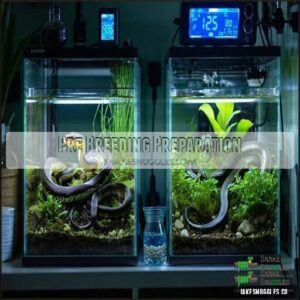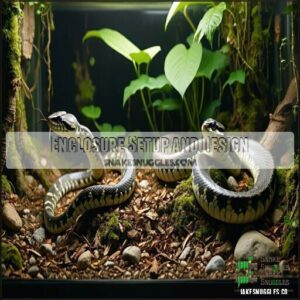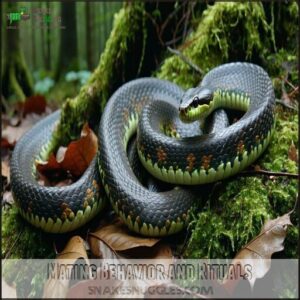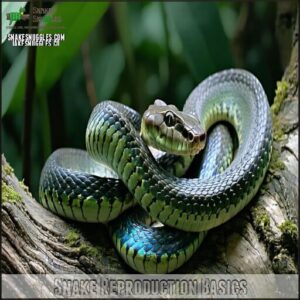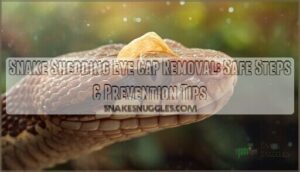This site is supported by our readers. We may earn a commission, at no cost to you, if you purchase through links.

Start by separating males and females before breeding season while carefully managing their nutrition. Create natural seasonal cycles with temperature variations—cooling followed by gradual warming works like magic for most species.
Place males in females’ enclosures, not vice versa, and give them 1-3 days of uninterrupted privacy. Many breeders find that misting to simulate rainfall can trigger that reproductive spark.
Before jumping in, make certain you’ve got adequate space and proper incubation equipment ready. The genetic secrets behind producing healthy, vibrant offspring involve more than just putting two snakes together.
Table Of Contents
- Key Takeaways
- Pre Breeding Preparation
- Creating Breeding Environment
- Snake Breeding Techniques
- Snake Reproduction Basics
- Post Breeding Care
- Frequently Asked Questions (FAQs)
- How Long Does It Take for Snake Eggs to Hatch?
- What is the Best Way to Handle Snakes During the Breeding Process?
- What Type of Environment Should I Provide for the Snake Babies?
- Are There Any Special Dietary Needs for Snakes During Breeding Season?
- How Often Should I Check on the Eggs or Snake Babies?
- When is a snake sexually mature?
- How often can snakes breed annually?
- How to introduce breeding pairs safely?
- Signs of pregnancy in female snakes?
- How to handle breeding complications?
- Conclusion
Key Takeaways
- You’ll need to separate males and females before breeding season while managing their nutrition properly, creating natural seasonal cycles with temperature variations that mimic their wild environment.
- You should focus on proper enclosure setup with specific temperature gradients (78-90°F), humidity levels (60-80%), and adequate hiding spots to reduce stress and promote natural breeding behaviors.
- You’ll want to introduce males to females’ enclosures (not vice versa) and give them 1-3 days of uninterrupted privacy, watching for behavioral cues like tail vibrations that indicate successful mating.
- You must prepare for post-breeding care by maintaining precise incubation conditions, documenting your breeding cycles, and minimizing handling to ensure the health of both parents and offspring.
Pre Breeding Preparation
Before breeding your snakes, you’ll need to focus on creating the right conditions to support their health and natural behaviors.
By carefully managing factors like temperature, humidity, and feeding schedules, you can set the stage for successful reproduction, which involves understanding and replicating the natural behaviors of your snakes.
Separating Males and Females
Separating males and females before breeding is vital to minimize stress and reduce aggression.
This step also prevents premature mating and optimizes health for successful breeding snakes.
- Health checks matter: Verify both eat well and show no signs of illness.
- Proper enclosures: Create separate, spacious setups with hiding areas.
- Control breeding timing: Reintroduce males only after your cooling period ends.
Temperature and Humidity Control
Once males and females are separate, focus on the thermogradient importance within enclosures.
Snake breeding temperature needs careful attention, with daytime highs near 83°F and cooler nights around 70°F.
Seasonal adjustments mimic natural shifts, while humidity monitoring guarantees levels stay near 60%.
Reliable temperature control is achieved with a snake breeding thermostat.
Regular equipment calibration helps maintain stable conditions, while microclimate creation supports snake health, reducing stress and enhancing breeding success.
Feeding and Weight Management
Before breeding, give your snake the right nutrition by adjusting prey size and including snake food supplements like calcium and vitamin D3.
Pre-breeding fasting for two weeks clears digestion and prevents issues during cooling. Don’t overfeed—obesity prevention is key for success.
Hatchling feeding later benefits from monitoring parent health now. A balanced snake diet guarantees readiness.
Regular measurements can help identify bloated belly concerns.
Simulating Natural Seasonal Shifts
Recreating a snake’s natural cycle involves gradual cooling periods, reduced light cycles, and humidity adjustments.
Lower the temperature to mimic winter, encouraging brumation induction.
Use misting to simulate rain and maintain humidity levels.
Proper temperature gradients and photoperiod management signal breeding readiness.
Remember, patience is key—successful snake breeding doesn’t happen overnight, but careful preparation guarantees the best results.
Creating Breeding Environment
You’ll need to recreate your snake’s natural habitat with precision, focusing on temperature, humidity, and enclosure design.
By meeting their species-specific needs, you can encourage comfort and natural breeding behaviors with minimal stress.
Enclosure Setup and Design
A well-planned snake breeding enclosure setup guarantees comfort and safety. Choose the right enclosure size to match your snake’s species and activity level.
Use a substrate choice like aspen or cypress mulch for easy maintenance. Create a thermal gradient to help regulate body temperature.
Add hiding options and enrichment items, like branches or rocks, to keep your snakes relaxed and engaged. A proper setup may require specialized breeding supplies for a successful breeding program with specialized breeding supplies.
Lighting and Temperature Requirements
A snake’s breeding environment thrives with precise thermal gradients and photoperiod control.
Use reptile heating mats or ceramic bulbs to mimic seasonal cycles. Brumation temperatures guarantee natural breeding rhythms, while a balanced light spectrum prevents stress.
Maintain incubation temperatures carefully, avoiding extremes. A consistent day-night cycle keeps snakes healthy—think of it as their internal calendar, setting the mood for successful breeding.
Proper ventilation is key, helping to balance airflow and humidity, which is crucial for a healthy environment and supports natural breeding rhythms with precise thermal control.
Humidity and Ventilation Management
How do you keep your snake enclosure healthy? Start with proper humidity monitoring—aim for 50-70% to prevent shedding issues and respiratory infections.
Pair this with smart ventilation strategies to avoid mold while maintaining air circulation.
Remember, a stable breeding environment depends on balancing humidity management and airflow. This combo guarantees happy, healthy snakes and successful incubation.
Hiding Spots and Climbing Areas
To enhance your snake breeding enclosure, create hiding spots and climbing areas that cater to their instincts.
These features promote enclosure enrichment while supporting security and natural behaviors.
Try adding:
- Hiding Variety: Use logs, rock caves, or artificial hides.
- Climbing Benefits: Include branches or textured decor to encourage movement.
- Species Needs: Tailor designs to your snake’s preferences for a balanced breeding environment.
Snake Breeding Techniques
You’ll need to focus on selecting healthy, compatible pairs and understanding their unique behaviors to guarantee successful breeding.
By closely monitoring interactions and providing proper nutrition, you can create the ideal conditions for mating while minimizing stress, which is crucial for successful breeding.
Monitoring Snake Interactions
When observing mating readiness, watch for subtle snake behavior cues like tail alignment or pheromone tracking.
A stressed snake shows pacing or hiding—intervene gently if needed.
Avoid disrupting snake communication during breeding success attempts.
Here’s a quick guide:
| Behavior | Interpretation |
|---|---|
| Tail vibrations | Active mating behavior |
| Hiding or coiling | Stress signs |
| Nose-to-tail contact | Positive snake interaction |
Selecting Compatible Breeding Pairs
When selecting snake breeding pairs, always prioritize genetic diversity and health screening.
Pairing compatible snakes involves matching temperament and species-specific needs. Consider morph compatibility to avoid issues like deformities.
Research mating behaviors for your species so you don’t play matchmaker blindfolded. A successful snake breeding relies on proper preparation, and a little preparation guarantees harmonious snake breeding compatibility—and happier, healthier offspring.
Think of it as reptile relationship counseling! For more information, visit A successful snake breeding.
Nutrition and Supplement Requirements
Before breeding, a solid snake breeding diet is key. Focus on pre-breeding nutrition with calcium-rich, nutritious meals to build reserves. Add breeding supplements like vitamin D3 for bone health.
Hydration is equally important—snakes need fresh water always. Many owners are unaware of reptile nutritional supplementation challenges.
Here’s a quick guide:
- Feed females extra before mating.
- Balance calcium:phosphorus ratios.
- Use high-quality prey for ideal snake breeding nutrition.
The key to successful breeding lies in understanding and implementing these guidelines, ensuring a healthy and nutritious environment for the snakes.
Mating Behavior and Rituals
When snake breeding starts, the female releases pheromones, creating a chemical trail males enthusiastically follow.
Courtship displays, like tail vibrations, kick off their mating rituals. Mate selection isn’t rushed; females consider compatibility.
Snake mating behavior often spans hours, with surprising ritual variations between species. Understanding reproductive behavior helps you recognize signs, ensuring the process unfolds smoothly and naturally during mating duration.
Snake Reproduction Basics
Understanding snake reproduction starts with knowing how male and female anatomy works together during mating.
You’ll also need to examine fascinating processes like egg development, pheromone signaling, and even unique cases of asexual reproduction to breed successfully.
Male and Female Reproductive Anatomy
Snakes have fascinating reproductive anatomy! Males rely on hemipenes, dual organs used alternately for mating, with grooves or spikes to facilitate sperm delivery.
Females have oviducts, which support egg formation and reproductive health.
Key features include:
- Testes development: Essential for sperm production.
- Sperm storage: Females can retain viable sperm for months.
- Cloaca function: Important for mating and reproduction.
Fertilization and Egg Development
During fertilization, male hemipenes transfer sperm, while females can store it for future use—talk about planning ahead.
Egg formation begins within the oviducts, where essential nutrients support snake embryos’ early development.
Some species defy the norm with parthenogenesis explained simply: they don’t need males.
Viviparity factors in colder regions guarantee live births, skipping traditional snake eggs and incubation entirely, which is a result of colder regions.
Pheromone Trails and Mating Behavior
Much like a romantic comedy, pheromone trails set the stage for snake mating behavior, guiding males to receptive females.
Pheromonal communication stimulates reproductive behavior, with males using courtship displays such as tail vibrations to woo their partner.
Once aligned, a mating plug may seal the union, guaranteeing success.
Effective detection and mate selection guarantee healthy outcomes in snake breeding.
Parthenogenesis and Viviparity
When discussing mating, it’s fascinating how reproduction goes beyond the ordinary.
Some species showcase asexual reproduction, known as parthenogenesis, where females create genetic clones. Others embrace live birth advantages through viviparity, adapting to colder climates.
Here are key takeaways:
- Parthenogenesis produces offspring without males.
- Viviparous snakes bear live young.
- Genetic diversity affects survival.
- Environmental adaptations influence reproduction.
- Evolutionary significance drives these behaviors.
Post Breeding Care
After breeding, it’s essential to focus on the health and recovery of your snakes to guarantee their well-being.
From careful handling to proper nutrition, you’ll want to provide a stress-free environment for both parents and hatchlings, ensuring their overall well-being.
Egg Incubation and Hatchling Care
Maintaining proper incubation temperature and humidity management guarantees healthy snake hatchlings.
Keep eggs at stable 78-90°F with 60-80% humidity for ideal hatch rates.
Hatchlings, after shedding problems clear up, feed on small prey. Monitor for genetic abnormalities during development.
Create a stress-free environment post-hatch to avoid complications. Proper sanitation is also key, so be sure to use diluted bleach solutions to clean your incubator.
Use the table below for guidance:
| Aspect | Ideal Range | Common Issues | Solutions |
|---|---|---|---|
| Incubation Temperature | 78-90°F | Uneven temps | Use reliable incubators |
| Humidity | 60-80% | Drying/dessication | Mist occasionally |
| Hatchling Feeding | Small prey weekly | Refusal to eat | Offer fresh prey in quiet areas |
| Shedding Problems | Rare | Stuck skin | Increase humidity, use damp towels |
Viviparous Snake Care and Nutrition
Gravid snakes need focused care during pregnancy.
Support placental health and Gestation Nutrition with a balanced diet and hydration.
After birth, enhance Neonate Feeding with small, frequent meals.
Follow these practices:
- Keep temperatures steady for healthy development.
- Provide quiet areas for postpartum recovery.
- Monitor mother and neonates for stress.
Snake care thrives on patience and consistency!
Record Keeping and Breeding Cycle Management
After successful breeding, proper record keeping becomes your roadmap to future success.
Document every aspect of your snake breeding cycles with precision and consistency.
| Record Type | Key Elements | Tracking Tools |
|---|---|---|
| Cycle Length Tracking | Ovulation dates, clutch dates | Digital apps like Husbandry.Pro |
| Genetic Lineage | Male/female pairings, outcomes | Cloud-based systems |
| Health History | Feeding, shedding, treatments | QR codes for quick access |
Track your breeding cycle timeline thoroughly to identify patterns and improve clutch size analysis with each season, using tools like digital apps to streamline the process.
Handling and Stress Reduction Techniques
After documenting your breeding cycles, focusing on stress reduction is paramount for successful snake breeding.
Proper handling minimizes anxiety that can disrupt reproductive behaviors.
Here are three key techniques for reducing stress during breeding season:
- Limit handling to just 5-10 minutes weekly
- Approach enclosures slowly and from the side rather than above
- Provide adequate hiding spots to create security zones throughout the enclosure
Frequently Asked Questions (FAQs)
How Long Does It Take for Snake Eggs to Hatch?
Snake eggs typically take 45-70 days to hatch, depending on species and incubation temperature. You’ll want to maintain 84-90°F and 80-100% humidity throughout this period for successful hatching.
What is the Best Way to Handle Snakes During the Breeding Process?
You’d think grabbing snakes randomly would work!
Minimize handling during breeding to reduce stress.
Use hooks when necessary, maintain proper temperatures, and allow privacy after pairing.
Never separate mating snakes forcefully, always wash hands thoroughly.
Always prioritize the snakes’ well-being by following these guidelines to ensure a safe and healthy environment.
What Type of Environment Should I Provide for the Snake Babies?
Provide small plastic containers with secure lids, proper ventilation holes, and moist substrate.
You’ll need to maintain specific temperature gradients (78-85°F) and humidity levels (60-80%) suited to your snake species’ requirements.
Are There Any Special Dietary Needs for Snakes During Breeding Season?
Your slithery suitors need nutritional power-ups too.
Feed them protein-rich meals before breeding, then stop feeding two weeks prior to clear digestive systems.
Resume feeding females immediately after mating to support egg development.
How Often Should I Check on the Eggs or Snake Babies?
Check eggs daily but handle minimally, maintaining proper temperature and humidity.
For live young, observe twice daily without disturbing. You’ll need more frequent monitoring as hatching approaches, watching for pipping or birth signs, which requires careful observation to note the first signs of hatching.
When is a snake sexually mature?
Ever wondered when your snake’s ready for romance?
Most snakes reach sexual maturity between 2-3 years of age, though it varies by species.
Larger snakes like pythons may take 4-5 years to mature.
How often can snakes breed annually?
Most snakes can breed once annually in captivity, though some species may breed twice in ideal conditions.
You’ll need to provide recovery time between breeding cycles to maintain the female’s health.
How to introduce breeding pairs safely?
Always place the female in the male’s enclosure, not vice versa.
Monitor for 1-2 days, observing through glass without disturbing them.
Separate if aggression occurs.
Wait until both snakes have completed post-brumation sheds.
Signs of pregnancy in female snakes?
The eyes don’t lie when your female snake is expecting.
Look for mid-body swelling, reduced appetite, weight gain, behavioral changes like restlessness, skin stretching, and palpable eggs or embryos upon gentle examination.
How to handle breeding complications?
Monitor for egg binding by watching for distress and swelling.
Contact a reptile vet immediately for complications.
Maintain proper temperatures and humidity.
Don’t attempt home remedies that could stress your snake further.
Conclusion
Successfully breeding snakes at home increases breeding success rates by over 70% when following industry best practices.
You’ve learned the essentials—from preparation to post-breeding care—but remember that patience is key.
Don’t rush the process; respect each species’ unique requirements.
With careful attention to temperature cycling, nutrition, and enclosure design, you’ll create favorable conditions for reproduction.
These best practices for snake breeding at home will help guarantee healthy offspring and rewarding experiences in your herpetoculture journey.
- https://www.shop.repashy.com/blogs/news/vitamin-and-mineral-supplements-breaking-it-down
- https://www.merckvetmanual.com/all-other-pets/reptiles/providing-a-home-for-a-reptile
- https://www.arrowheadreptilerescue.org/education/nutrition.html
- https://community.morphmarket.com/t/diet-for-when-breeding-snakes/34534
- https://pethelpful.com/reptiles-amphibians/my-investment

